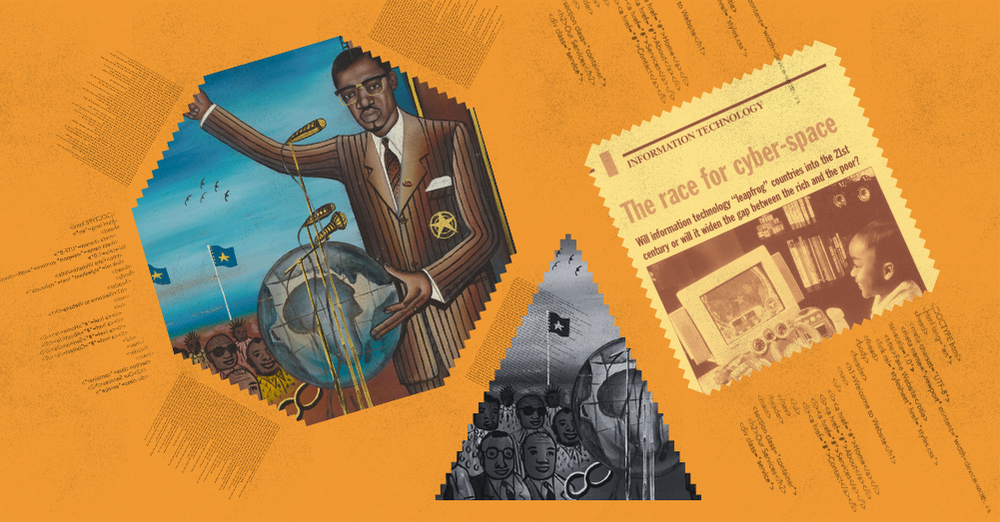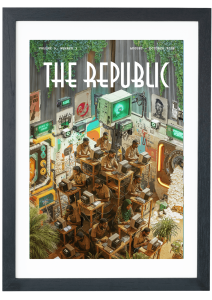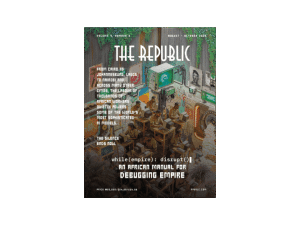
Photo illustration by Dami Mojid / THE REPUBLIC. Ref 1: Patrice Émery Lumumba’s Independence Day speech, DRC, 1960 / SMITHSONIAN LAB. Ref 2: African Review, 1997 / ARCHIVING.
THE MINISTRY OF SCIENCE X TECHNOLOGY
Africa’s Geopolitics Needs a Digital Upgrade

Photo illustration by Dami Mojid / THE REPUBLIC. Ref 1: Patrice Émery Lumumba’s Independence Day speech, DRC, 1960 / SMITHSONIAN LAB. Ref 2: African Review, 1997 / ARCHIVING.
THE MINISTRY OF SCIENCE X TECHNOLOGY
Africa’s Geopolitics Needs a Digital Upgrade
On the morning of 11 February 1889, as Japan prepared for the unveiling of the Meiji government’s new imperial constitution, Mori Arinori, the minister of education, lay bleeding on his deathbed. He had just been stabbed by a bereaved nationalist who believed that Arinori was an enemy of the state for his openly Western ideologies and his proposed educational reforms. This was because at the time, Japan was going through one of the most rapid socio-cultural reforms in history, the Meiji Restoration, which usurped Japan’s traditional political structure, social strata and institutions in a bid to catch up to Western countries and avoid colonization. Arinori’s brutal assassination was the culmination of the angst that traditional Japanese people felt at the time, and more importantly, a signifier of how harsh the Meiji reforms were to Japan and its people, who had to give up their way of life, and their social and economic structures in a dire attempt for global relevance and protection from Western annexation.
While Japan is one of the few countries in the world that was never colonized, ironically, it still had to go through radical social, economic and institutional reforms to align with Western needs. This shows how heavy the hand of European hegemony was on the nations of the world. By 1914, 84 per cent of the world’s nations had been colonized by Europeans, and many of them had to also undergo political, economic and social reforms to align with the needs of their colonizers. This is even more interesting when you consider that Europe has a smaller population and less access to natural resources than a lot of these countries. Philip Hoffman, a professor of history and social science at the California Institute of Technology, attributes this to the power disparity created by differences in military-technological advancement (gunpowder and firearms) between Europe and other countries. A telling example of this can be seen in the United States’ first contact with Japan in 1853, which was through a squadron of armed gunships and an order to establish trade relations with the United States.
Evidently, technological advancement is a potent determinant of power and the geopolitical dynamics between nations. British and American industrialization coupled with technology-enabled imperialism, fortified them as world powers over other countries. But, with the rapid industrialization and growth of other nations, many countries are beginning to rival Western dominance and seek full autonomy over their nations. A prominent example is the formation of BRICS in 2009, an intergovernmental organization made up of ten member states—Brazil, Russia, India, China, South Africa and, more recently, Egypt, Ethiopia, Iran and the United Arab Emirates—whose aim is to create a counterweight to Western influence on global (financial) institutions.
TECHNOLOGY AND THE DYNAMICS OF DEEPSEEK
Currently, the technological disparity between the West and other countries has narrowed to a crucial point. A point where other nations can begin to leverage their domestic technological prowess and international collaboration to gain significant global influence. With the rapid commercialization and adoption of AI, ‘the new electricity’, the possibilities of increased global influence and independence has become increasingly likely.
This is the precedent for the current geopolitical tensions between the United States and China, after the announcement of a Chinese-made generative AI model, Deepseek. Early this year, China startled the world with the unveiling of Deepseek-R1—an open-source generative AI model comparable to its Western counterparts, OpenAI’s ChatGPT and Perplexity. Deepseek is unique, mainly because of how cost-efficient it is due to the architecture of its model, called Mixture of Experts (MOE). MOE is a type of neural network architecture that allows machine learning systems to scale efficiently by delegating tasks to multiple specialized models instead of using the entire model for every input. By doing so, MOE reduces the resources spent on AI training and development cycles, making it an ideal alternative for small and medium businesses.
The US responded to this by restricting Deepseek from being used in government processes and devices as well as going further to extend its export controls on American technology company, Nvidia’s advanced computer chips—a tactic they claim will make sure ‘the world’s AI runs on American rails’ and keep it out of the hands of ‘malicious actors’ who could use it to threaten the US. However, Paulo Aguiar, a geopolitical risk analyst, believes that such sanctions, which are supposed to be a scheme to limit China’s access to technology, will instead improve China’s military and economic power.
Despite the strict trade barriers limiting Chinese companies’ access to key resources for the development of generative AI, their ecosystem continues to thrive. Alibaba, multinational technology company, released a family of large language models called Qwen in January 2025 and in April 2025, DeepSeek AI released DeepSeek-R1-0528, which is a more optimized model, positioned to soon catch up with OpenAI’s GPT-4.5 or Google’s Gemini 2.5. These two instances show the resilience of the Chinese AI community and their burgeoning capacity for self-reliance.
WHERE DOES AFRICA FIT INTO THIS?
While Asia and the West take centre stage by building generative models and engaging in policy battles, the rest of Africa should not remain on the bench. Mondli Gungubele, South Africa’s minister of communications and digital technology supports this by saying: ‘The era of generative AI is just beginning, and as a country and a continent we cannot and must not allow ourselves to be left behind.’
The Nigerian government seems to also be intent on ‘not being left behind’ with President Bola Ahmed Tinubu initiating strategic partnerships with Sundar Pichai, the chief executive officer of Google, which are focused on building cloud infrastructure, skill acquisition, AI research and innovation, cloud adoption and improving the country’s global standing. While this is a proactive and ultimately beneficial initiative, it was met with scathing criticism from thousands of Nigerians on social media platforms, who believed that the government should address the issues of rampant poverty, inadequate infrastructure and the national degradation of the quality of life before pursuing goals like AI adoption and partnerships.
The sentiment of these Nigerians is not unfounded. According to the World Bank Group in 2018, sub-Saharan Africa is the lowest-ranking region in terms of infrastructural performance, which indicates a troublesome gap in key infrastructure in Africa. This, coupled with the statistic that the region accounts for 67 per cent of the 700 million people experiencing global poverty, despite the region accounting for only 16 per cent of the global population, shows that Africa indeed has a lot more pressing issues to solve than AI adoption.
The unfortunate caveat to this is that, regardless of the developmental challenges faced by Africa, the region still cannot afford to be a bystander while another era of technology takes place. Much like Japan, Africa had to make grave socio-political and economic concessions under the influence of Western powers. Structural Adjustment Programmes (SAPs) in Africa are one of the most notorious examples of this. In the 1980s, many resource-dependent countries in Africa struggled with global price shocks and foreign debt, leading them to obtain International Monetary Fund loans as a last resort alternative. The condition for these loans was the implementation of the SAPs, which was supposed to reignite an era of economic stability and growth. Instead, African countries fell deeper into debt and suffered rampant illiteracy, poverty and mortality rates, which subsequently increased their reliance on foreign aid. The impact of the failed SAPs also affected the political climate of these countries. In a study conducted by political scientist Jeffrey Herbst in 1990, it was proven that the programmes made the political climate of these nations much more volatile, which explains the uprisings and revolts in Sudan in 1985 and Zambia in 1986 following their respective SAP implementations.
In a statement made by the Euro-Mediterranean Economists Association (EMEA) in 2025, its president, Prof. Rym Ayadi, illustrated the relationship between Africa’s development goals and its geopolitical influence. Their statement exposed how the lack of autonomy, over-reliance on aid and lack of global influence of African countries perpetuates their underdevelopment through high debt burden, political instability and reduced control over their natural resources, affirming the saliency of Gungubele’s message: ‘We cannot and must not allow ourselves to be left behind.’
African nations cannot continue to focus only on achieving economic stability without considering technological progress, because history and research have proven such an approach to be unreliable in the face of geopolitical weakness. Instead, African countries need to ardently create the environment, institutions and regulations that will foster the development of emerging technologies to improve Africa’s self-reliance and global competitiveness.
shop the republic
THE POTENTIAL OF AI ADOPTION IN AFRICA
Innovation Capacity
There are a few factors to consider when examining the potential for the development and adoption of AI in Africa. One of them is the innovation capacity of a nation. Innovation capacity is the ability of a country to produce and commercialize the flow of innovative technology over the long term. In Paul Kennedy’s The Rise and Fall of the Great Powers, he explains how a country’s innovative capacity is key to establishing technologically fuelled growth and obtaining geopolitical relevance, as long as the technological changes made are proportional to growth. The US’s rise to global stardom can be attributed to this. Their constant adoption of technological innovations such as steamboats, passenger trains and factory machines caused rapid industrialization and unprecedented growth—which all too quickly was transformed into military power and imperialism as a segue into achieving global dominance.
While Africa is unlikely to turn to imperialism for global dominance, there are many ways that African countries can build their innovative capacity in AI. According to a paper by Jeffrey L. Furman, Michael E. Porter and Scott Stern in 2000, a nation’s innovation capacity is determined by its quality of human capital, investment in research and development, infrastructure and institutional quality. Unfortunately, data shows that African countries are doing poorly in this regard. According to data from the World Bank, African countries spend an average of only 0.45 per cent of their Gross Domestic Product on research and development, which is far less than the global average of 1.7 per cent.
However, many African countries are working to rectify this gap. The South African government is solving this problem through their National AI Strategy Project. Over the past three years, the Artificial Intelligence Institute of South Africa has built four hubs for AI research and innovation, with its latest one, the Defence Artificial Intelligence Research Unit, being the first military-focused AI hub in Africa. These hubs are bound to improve South Africa’s AI capabilities and address pressing skill and research gaps in its economy. Alongside South Africa, many other African countries—including Nigeria, Kenya and Egypt—have developed AI strategies aimed at building their innovation capacity through initiatives such as investment in research, capacity building programmes and educational reforms.
Diffusion Capacity
Along with a nation’s innovative capacity, Professor Jeffery Ding, an assistant professor of political science at George Washington University, presents a different perspective for viewing a country’s technological competitiveness: its ability to leverage technology to sustain economic growth, or simply put, a nation’s diffusion capacity. The diffusion capacity of a country is its ability to adopt innovation across all productive sectors, like security, military and health. This concept is different but not unrelated to a country’s innovation capacity and is argued to be a better long-term measure of technological competitiveness.
The diffusion capacity of a country is determined by measures of digital adoption, including but not limited to, digitally enabled businesses, access to Information Communication Technology infrastructure and cloud computing adoption, amongst others. For African countries, digital adoption is already an ongoing challenge. According to the International Telecommunication Union, only 38 per cent of the African population uses the internet, while the global average for internet usage is 68 per cent. Also, further studies show that less than 25 per cent of African businesses use digital technology for key operational and productive tasks. This reflects lower capacity for AI diffusion in African countries, especially in comparison to their global counterparts and presents a huge bottleneck to AI adoption strategies.
For Africa to attain long-term technological competitiveness, the region needs to focus on innovation that can impact a large portion of its population and not only an entrenched minority. One of the most prominent conditions for technologically enabled global influence made by Kennedy in The Rise and Fall of the Great Powers is that technological change should be commensurate with economic growth. If African countries only pour millions into technological research and development without addressing key digital gaps and marginalized groups, they risk gaining unwanted results and ineffective policies.
Fortunately, Africa has the youngest population in the world, with 70 per cent of Africans under the age of 30. If digital adoption and development policies are implemented successfully, the technology-driven growth generated from its large and digitally enabled labour force would be on a colossal scale. Many initiatives and policies are also being employed to actualize this; the Digital Economy for Africa Initiative by the World Bank has been actively working to address the digital divides since 2019 and has supported 70 digitalization projects across 37 countries, totalling $9 billion in investments.
shop the republic
Development of AI Infrastructure
In a March 2025 interview with Business Insider Africa, Arthur Mensch, the CEO of French artificial intelligence startup Mistral AI, stressed the importance of developing local AI infrastructure for every nation, explaining that dependence on other countries would risk investment returns flowing to those countries and reduce estimated national growth for the dependent nation. This is especially crucial for African countries that have a history of dependence on other nations. If African countries are aiming to increase their geopolitical competitiveness, they cannot continue to do that on the back of foreign nations.
Chinese AI firms have learnt this lesson the hard way through their reliance on US technology firms like Nvidia for the supply of AI chips and semiconductors. This dependency has been exploited through US export restrictions, which serve as a tool to limit and control the pace of China’s technological advancement. In response, China has begun to pursue a path of self-reliance by implementing incentives to support domestic AI production through subsidies for companies using domestically produced AI chips.
Fortunately, some Africans are already working to prevent an AI-dependence cycle. One of them is the Zimbabwean billionaire Strive Masiyiwa, who is currently partnering with Nvidia to build Africa’s first artificial intelligence factory with expansion planned across Egypt, Kenya, Morocco and Nigeria. This is a promising opportunity for African countries to leverage intra-continental collaboration and domestic infrastructure for developing uniquely African AI solutions and reduce its dependence on foreign nations.
shop the republic
-
‘The Empire Hacks Back’ by Olalekan Jeyifous by Olalekan Jeyifous
₦70,000.00 – ₦75,000.00Price range: ₦70,000.00 through ₦75,000.00 This product has multiple variants. The options may be chosen on the product page -
‘Make the World Burn Again’ by Edel Rodriguez by Edel Rodriguez
₦70,000.00 – ₦75,000.00Price range: ₦70,000.00 through ₦75,000.00 This product has multiple variants. The options may be chosen on the product page -
‘Nigerian Theatre’ Print by Shalom Ojo
₦150,000.00 -
‘Natural Synthesis’ Print by Diana Ejaita
₦70,000.00 – ₦75,000.00Price range: ₦70,000.00 through ₦75,000.00 This product has multiple variants. The options may be chosen on the product page
THE ROAD AHEAD
The emergence of AI has opened up new frontiers of possibilities for nations, especially African countries that have been marginalized from engaging in geopolitical affairs for far too long. It is up to the Global South to leverage technological advancement for increased global competitiveness and domestic autonomy, which is key to achieving their development goals and accelerating the growth of these nations.
Emergent digital and AI policies in African countries should focus not just on investment in innovation and research but also on creating a more digitally proficient population that improves technology diffusion and ensures that growth is inclusive. Strategic incentives should also be implemented to improve adoption of emerging technologies across all sectors of our economies.
These policies should also emphasize the production of domestic AI resources and infrastructure, which include but are not limited to data centres, cloud computing, processing units and AI talent generation.
In terms of the dangers of AI, strict regulations should be enforced to mitigate risks involved with generative AI adoption and development. Policymakers in African countries should address the risks and fears of AI development with as much tenacity as their Western and Asian counterparts who have already established and implemented data protection and artificial intelligence regulations⎈
shop the republic
BUY THE MAGAZINE AND/OR THE COVER
-
‘Make the World Burn Again’ by Edel Rodriguez by Edel Rodriguez
₦70,000.00 – ₦75,000.00Price range: ₦70,000.00 through ₦75,000.00 This product has multiple variants. The options may be chosen on the product page -
The Republic V9, N2 Who Dey Fear Donald Trump? / Africa In The Era Of Multipolarity
₦40,000.00
















